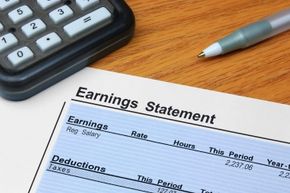You might be pleased with the large number listed under "gross" on your pay stub. Chances are, though, that the "net" section is significantly smaller. That's because, for individual taxpayers, gross income is the total amount you're paid, while your net income is what you end up with after several required deductions.
What that means is your net income is the amount you actually bring home after your employer takes out Social Security and Medicare contributions, as well as federal, state and local taxes. Some employers also have funds deducted for health or dental insurance, retirement plans, disability or life insurance, and professional association dues.
Advertisement
It's easy to determine your annual net income. First, you have to know how you're paid: weekly, every two weeks, twice a month or monthly. Next, multiply your net pay by the total number of checks you receive over the year. That's 52 if you're paid weekly, 26 for every two weeks, 24 for twice a month, and 12 for monthly. The result is your net income for the year [source: Freddie Mac]. This is the amount you actually have for your expenses, such as food, housing, clothing, entertainment and savings.
Businesses also differentiate between gross and net income. The gross is figured by combining earnings from goods or services with other proceeds, such as investment gains, bank interest and bad debts that were previous tax write-offs but have since been collected. To find the net income of your business, subtract its business expenditures from the gross. These outlays vary from business to business but may include payroll expenses, consultant fees, cost of raw materials, overhead, taxes and interest on loans.
While a business wants a high gross income, rising earnings often coincide with rising costs. As money is paid out for more workers, new facilities and greater taxes, net income can drop significantly. Though gross includes everything that comes in, the net income gives a more realistic idea of a business's health. Keeping track of the monthly net of your business over time will help you prepare for its inevitable highs and lows, and, hopefully, keeps the lows from becoming too scary.
Advertisement



